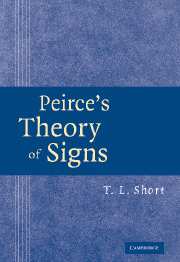Book contents
- Frontmatter
- Contents
- Preface
- Acknowledgments
- 1 Antecedents and Alternatives
- 2 The Development of Peirce's Semeiotic
- 3 Phaneroscopy
- 4 A Preface to Final Causation
- 5 Final Causation
- 6 Significance
- 7 Objects and Interpretants
- 8 A Taxonomy of Signs
- 9 More Taxa
- 10 How Symbols Grow
- 11 Semeiosis and the Mental
- 12 The Structure of Objectivity
- Bibliography
- Name Index
- Subject Index
11 - Semeiosis and the Mental
Published online by Cambridge University Press: 28 July 2009
- Frontmatter
- Contents
- Preface
- Acknowledgments
- 1 Antecedents and Alternatives
- 2 The Development of Peirce's Semeiotic
- 3 Phaneroscopy
- 4 A Preface to Final Causation
- 5 Final Causation
- 6 Significance
- 7 Objects and Interpretants
- 8 A Taxonomy of Signs
- 9 More Taxa
- 10 How Symbols Grow
- 11 Semeiosis and the Mental
- 12 The Structure of Objectivity
- Bibliography
- Name Index
- Subject Index
Summary
Peirce's early semeiotic was a theory of mind: it identified thoughts as signs interpreting signs. The mature semeiotic retains that identification but embeds it in a wider context. There are signs outside thought that thought interprets, and there are interpretants outside thought as well, in animal behavior especially. Thought itself is interpretable in behavior. It thus becomes possible to conjecture a natural history of thought: perhaps the capacity to think evolved from more primitive forms of semeiosis, when our ancestors began to interpret signs by other signs rather than directly in action.
The mature semeiotic entails a naturalistic theory of mind also in another respect: it explains significance (chapter 6, section 10), and the intentionality of thought is a special case of significance. A sign's significance is its bearing on the purposes of possible interpreters, and purpose, which may be practical or not, is not always conscious or otherwise dependent on an individual mind. The attribution of purpose, although it grounds valuation, is an empirical hypothesis, testable against observation. And the explanation of purposeful behavior, although not mechanistic, is naturalistic. In particular, thought's significance consists in its being interpretable, ultimately, in conduct. Pragmatism, which in 1878 was a maxim for the clarification of ideas, thus became in 1907 part of a naturalistic account of thought. It accounts for how we can think of what is, that exists independently of the thought of it, and also for how we can think of what is not.
- Type
- Chapter
- Information
- Peirce's Theory of Signs , pp. 289 - 316Publisher: Cambridge University PressPrint publication year: 2007



